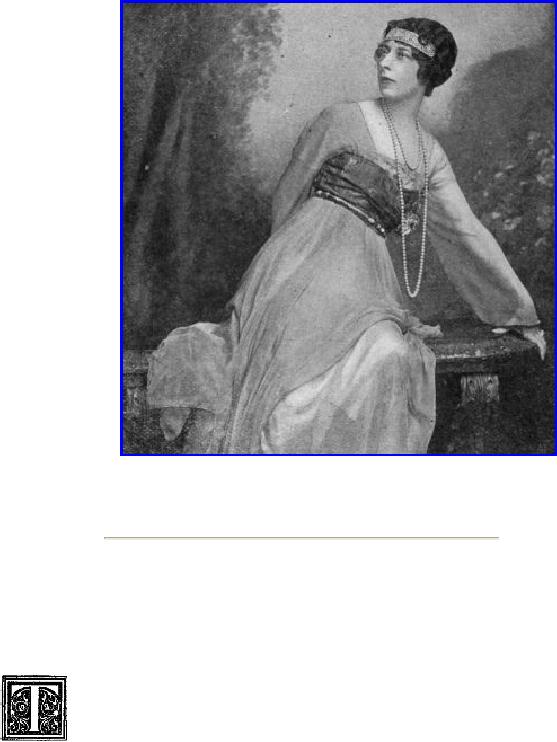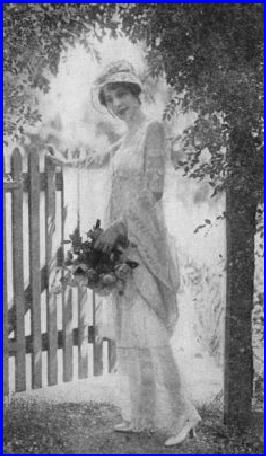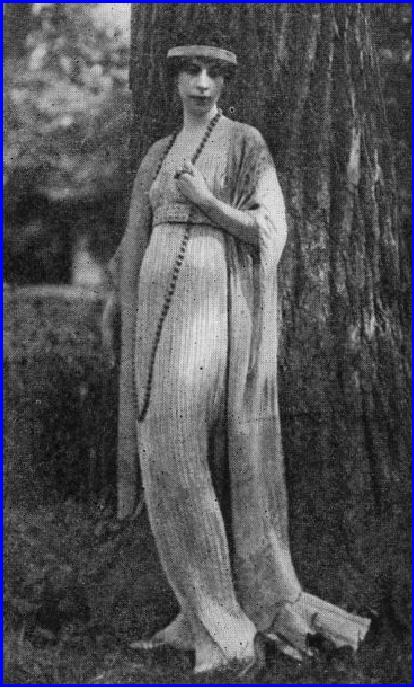 |
DEVELOPMENT OF GOTHIC COSTUME |
| << I. THE STORY OF PERIOD COSTUMES:II. EGYPT AND ASSYRIA |
| THE RENAISSANCE >> |

Mrs.
Cond� Nast in Evening
Dress
CHAPTER
XVI
DEVELOPMENT
OF GOTHIC COSTUME
O
the
Romans, all who were
not of Rome and her Empire,
were
foreigners,--outsiders,
people with a strange viewpoint, so they
were
given
a name to indicate this; they
were called
"barbarians."
Conspicuous
among those tribes of barbarians, moved
by human lust for gain
to
descend
upon the Roman Empire
and eventually bring about
its fall, was the
tribe
of
Goths, and in the course of centuries
"Gothic" has become a
generic term,
implying
that which is not Roman. We
speak of Gothic architecture,
Gothic art,
Gothic
costumes, when we mean, strictly
speaking, the characteristic
architecture,
art
and costuming of the late
Middle Ages (twelfth to fifteenth
centuries).
But
we find the so-called Gothic
outline in costume as early as
the fourth century.
Over
the undraped, one-piece robe of classic
type, a second garment is
now worn,
cut
with straight lines. It
usually fastens behind, and the
uncorseted figure is
outlined.
The neck is still collarless
and cut round, the space
filled in with a
necklace.
The sleeves of the tunic
appear to be the logical
evolution of the folds
of
the
toga, which fall over
the arms when bent. They
cling to the outline of
the
shoulder,
broadening at the hand into
what is called "angel" sleeves; in
art, the
traditional
angel wears them.
Roman-Christian
women wore their hair
parted, no Psyche knot, and
interesting,
large
earrings. The gowns were
not draped, but were in one
piece and with no
fulness.
A tunic, following lines of
the form, reached below
the knees and was
belted.
This garment was trimmed
with bands from shoulders to
hem of tunic and
kept
the same width throughout,
if narrow; but if wide, the
bands broadened to the
hem.
The neck continued to be cut
round, and filled in with a
necklace.
The
cape, fastening on shoulders or
chest, remnant of the Greek
toga, was worn,
and
veils of various materials
were the usual head
coverings.
Between
the fifth and tenth
centuries there are examples
of the overgarment or
tunic
having a broad stomacher of some
contrasting material, held in place
with a
cord,
which is tied behind,
brought around to the front,
knotted and allowed to
hang
to
bottom of skirt.
Byzantine
art between 800 and 1000 A. D. still
shows women wearing tunics,
but
hanging
straight from neck to hem of
skirt, fastened on shoulders and opened
at
sides
to show gown beneath; close
sleeves with trimming at the
wrists, often large,
roughly
cut jewels forming a border
on tunic, and the hair worn
in long braids on
each
side of the face; the
coil of hair, which was
wrapped with pearls or
other
beads,
was parted and used to frame
the face.
This
fashion was carried to excess by
the Franks. We see some of
their women
between
400 and 600 A. D. wearing these heavy,
rope-like braids to the hem of
the
skirt
in front.
In
the fourteenth century the
Gothic costume was perhaps
at its most beautiful
stage.
The long robe, the
upper part following the
lines of the figure, with
long
close
sleeves half covering hands, or
flowing sleeves, that touched
the floor. About
the
waist was worn a silk cord
or jewelled girdle, finely
wrought and swung low
on
hips;
from the end of which was
suspended the money bag,
fan and keys.
The
girdle begins now to play an
important part as decoration.
This theme, the
evolution
of the girdle, may be
indefinitely enlarged upon
but we must not
dwell
upon
it here.
In
some cases we see that
the tunic opened in the
front and that the
large, square,
shawl-like
outer garment of Greece now
became the long circular
cape, clasped on
the
chest (one or two clasps), made so
familiar by the art of the
Gothic and
Renaissance
periods. Turn to the illuminated
manuscripts of those periods, to
paintings,
on wood, frescoes, stained glass, stucco,
carved wood, and stone,
and
you
will find the Mother of God
invariably costumed in the
simple one-piece robe
and
circular clasped
cape.
In
most of the sacred art of
the tenth, eleventh,
twelfth, thirteenth, fourteenth
and
fifteenth
centuries, the Virgin and
other saints are depicted in the
current costume
of
woman. The Virgin was the
most frequent subject of
artists in every
medium,
during
the ages when the
Church dominated the State
in Europe.
The
refurnishing of the Virgin's
wardrobe has long been
and still is, a pious
task
and
one clamoured for by adherents to the
churches in which the
Virgin's image is
displayed
to worshippers. We regret to say,
for �sthetic reasons, that
there is no
effort
made on the part of modern
devotees to perpetuate the beautiful
medi�val
type
of costume.
In
some old paintings which
come under the head of Folk
Art, the Holy
Family
appears
in national costume. The
writer recalls a bit of
eighteenth century
painting,
showing
St. Anne holding the
Virgin as child. St. Anne
wears the bizarre f�te
attire
of
a Spanish peasant; a gigantic head-dress
and veil, large earrings,
wide stiff skirts,
showing
gay flowers on a background of
gold. The skirt is rather
short, to display
wide
trousers below it. Her
sleeves have filmy frills of
deep white lace
executed
with
skill.
PLATE
XXI
Mrs.
Cond� Nast in a garden costume.
She
wears
a sun-hat and carries a
flower-basket,
which
are decorative as well as
useful.
We
have chosen this photograph as
an
example
of a costume made
exquisitely
artistic
by being kept simple in line
and free
from
an excess of trimming.
This
costume is so decorative that it
gives
distinction
and interest to the least
pretentious
of
gardens.

Mrs.
Cond� Nast in
Garden
Costume
To
return to the girdle, as we
have said, it slipped from
its position at the waist
line,
where
it confined the classic folds, and was
allowed to hang loosely
about the hips,
clasped
low in front. From this
clasp a chain extended, to which
were attached the
housewife's
keys or purse and the dame of
fashion's fan. In fact one can
tell, to a
certain
extent, the woman's class
and period by carefully inspecting
her chatelaine.
The
absence of waist line, and
the long, straight effect
produced in the body
of
gown
by wearing the girdle swung
about the hips, gives it
the so-called Moyen
Age
silhouette,
revived by the fashion of
to-day.
In
the thirteenth century the
round collarless neck, low
enough to admit a
necklace
of
links or beads, persists. A new
note is the outer sleeve laced
across an inner
sleeve
of white.
Let
us remember that the costume
of the thirteenth and fourteenth
centuries was
distinguished
by a quality of beautiful, sweeping line,
massed colour, detail
with
raison
d'�tre, which
produced dignity with
graceful movement, found
nowhere to-
day,
unless it be on the Wagnerian
stage or in the boudoir of a
woman who still
takes
time, in our age of hurry,
to wear her neglig�e
beautifully.
In
the fourteenth century the
round neck continued, but
one sees low necks
too,
which
left the shoulders exposed
(our 1830 style).
Another
new note is the tunic
grown into a garment
reaching to the feet, a
one-
piece
"princess" gown, with belt
or girdle. Sometimes a Juliet cap was
worn to
merely
cover the crown of head,
with hair parted and flowing,
while on matrons we
see
head coverings with sides
turned up, like ecclesiastical
caps, and floating
veils
falling
to the waist.
Notice
that through all the periods
that we have named, which
means until the
fourteenth
century, the line of
shoulder remains normal and
beautiful, sloping and
melting
into folds of robe or line of sleeve. We
see now for the
first time an
inclination
to tamper with the shoulder
line. An inoffensive scallop
appears,--or
some
other decoration, as cap to sleeve. No
harm done yet!
The
fifteenth century shows
another style, a long sleeveless
overgarment, reaching
to
the floor, fastened on shoulders and
swinging loose, to show at sides
the
undergown.
It suggests a priest's robe. Here we
discover one more of the
Moyen
Age
styles revived
to-day.
The
fourteenth century gowns,
with necks cut out round, to
admit a necklace with
pendants,
are still popular. The
gowns are long on the
ground, and the most
beautiful
of the characteristic head-dresses--the
long, pointed one, with
veil
covering
it, and floating down from
point of cap to hem of
flowing skirt behind,
continues
the movement of costume--the
long lines which follow one
another.
When
correctly posed, this
pointed head-dress is a delight to
the eye. We recently
saw
a photograph of some fair
young women in this type of
Medi�val or Gothic
costume
worn by them at a costume
ball. Failing to realise that
the pose
of
any head
-dress
(this means hats as well) is
all-important, they had placed the
quaint, long,
pointed
caps on the very tops of
their heads, like fools'
caps!
The
angle at which this
head-dress is worn is half
the battle.
The
importance of every woman's
cultivating an eye for line
cannot be overstated.
In
the fifteenth century we
first see puffs at the
elbow, otherwise the
outlines of
gown
are the same. The
garment in one piece, the body of it
outlining the form,
its
skirts
sweeping the ground; a
girdle about the hips, and
long, close or flowing
sleeves,
wide at the hem.
Despite
the fourteenth century
innovation of necks cut low and
off the shoulders
(berated
by the Church), most necks in
the fifteenth century are
still cut round at
the
throat,
and the necklace worn instead of
collar. Some of the gowns
cut low off
the
shoulders
are filled in with a puffed
tucker of muslin. The
pointed cap with a
floating
veil is still seen.
Notice
that the restraint in line,
colour and detail, gradually
disappears, with the
abnormal
circulation of wealth, in those
departments of Church and State to
which
the
current of material things was
diverted. We now see
humanity tricked out
in
rich
attire and staggering to its
doom through general
debaucheries.
Rich
brocades, once from Damascus, are
now made in Venice; and so
are
wonderful
satins, velvets and silks, with
jewels many and
massive.
Sometimes
a broad jewelled band crossed the
breast from shoulder
diagonally to
under
arm, at waist.
The
development of the petticoat begins
now. At first we get only a
glimpse of it,
when
our lady of the pointed
cap lifts her long
skirts, lined with another
shade. It is
of
a rich contrasting colour and is
gradually elaborated.
The
waist-line, when indicated, is
high.
A
new note is the hair,
with throat and neck
completely concealed by a white veil,
a
style
we associate with nuns and
certain folk costumes. As fashion it had
a passing
vogue.
Originally,
the habit of covering
woman's hair indicated
modesty (an idea
held
among
the Folk), and the gradual
shrinking of the dimensions of
her coif, records
the
progress of the peasant
woman's emancipation, in certain
countries. This is
especially
conspicuous in Brittany, as M. Anatol Le
Braz, the eminent
Breton
scholar,
remarked recently to the
writer.
Note
the silk bag, quite
modern, on the arm; also the
jewelled line of chain
hanging
from
girdle down the middle of
front, to hem of skirt,--both
for use and ornament.
To
us of a practical era, a mysterious
charm attaches to the
long-pointed shoes
worn
at this period.
In
the fifteenth century, the
marked division of costume
into waist and skirt
begins,
the
waist line more and more
pinched in, the skirt
more and more full, the
sleeves
and
neck more elaborately
trimmed, the head-dresses
multiplied in size,
elaborateness
and variety. Textiles developed
with wealth and
ostentation.
In
the sixteenth century the
neck was usually cut out and
worn low on the
shoulders,
sometimes filled in, but we
see also high necks; necks
with small ruffs
and
necks with large ruffs;
ruffs turned down, forming
stiff linen-cape
collars,
trimmed
with lace, close to the
throat or flaring from neck
to show the throat.
The
hair is parted and worn low in a snood,
or by young women, flowing.
The ears
are
covered with the
hair.
PLATE
XXII
Mrs.
Cond� Nast wearing one of the
famous
Fortuny
tea gowns.
This
one has no tunic but is
finely pleated, in
the
Fortuny manner, and falls in
long lines,
closely
following the figure, to the
floor.
Observe
the decorative value of the
long
string
of beads.

Mrs.
Cond� Nast in a Fortuny Tea
Gown
The
Virgin in Art
When
writing of the Gothic period
in The
Art of Interior
Decoration, we have
said
"...
Gothic art proceeds from
the Christian Church and stretches
like a canopy over
western
Europe during the late
Middle Ages. It was in the churches
and
monasteries
that Christian Art, driven
from pillar to post by wars, was
obliged to
take
refuge, and there produced
that marvellous development
known as the Gothic
style,
of the Church, for the
Church and by the Church,
perfected in countless
Gothic
cathedrals, crystallised glorias,
lifting their manifold
spires to heaven;
ethereal
monuments of an intrepid Faith
which gave material form to
its adoration,
its
fasting and prayer, in an unrivalled
art..."
Table of Contents:
- A FEW HINTS FOR THE NOVICE WHO WOULD PLAN HER COSTUMES
- THE LAWS UNDERLYING ALL COSTUMING OF WOMAN
- HOW TO DRESS YOUR TYPE
- THE PSYCHOLOGY OF CLOTHES
- ESTABLISH HABITS OF CARRIAGE WHICH CREATE GOOD LINE
- COLOUR IN WOMAN'S COSTUME
- FOOTWEAR
- JEWELRY AS DECORATION
- WOMAN DECORATIVE IN HER BOUDOIR
- WOMAN DECORATIVE IN HER SUN-ROOM
- I. WOMAN DECORATIVE IN HER GARDEN:WOMAN DECORATIVE ON THE LAWN
- WOMAN AS DECORATION WHEN SKATING
- WOMAN DECORATIVE IN HER MOTOR CAR
- HOW TO GO ABOUT PLANNING A PERIOD COSTUME
- I. THE STORY OF PERIOD COSTUMES:II. EGYPT AND ASSYRIA
- DEVELOPMENT OF GOTHIC COSTUME
- THE RENAISSANCE
- EIGHTEENTH CENTURY
- WOMAN IN THE VICTORIAN PERIOD
- SEX IN COSTUMING
- LINE AND COLOUR OF COSTUMES IN HUNGARY
- STUDYING LINE AND COLOUR IN RUSSIA
- MARK TWAIN'S LOVE OF COLOUR IN ALL COSTUMING
- THE ARTIST AND HIS COSTUME
- IDIOSYNCRASIES IN COSTUME
- NATIONALITY IN COSTUME
- MODELS
- WOMAN COSTUMED FOR HER WAR JOB
- IN CONCLUSION